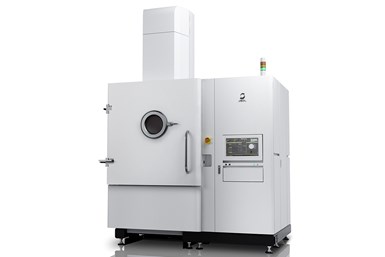JEOL Installing Metal 3D Printer at Cumberland Additive
This will be the first installation of JEOL’s E-beam system in North America, giving it new opportunities to demonstrate the abilities of the system in a dedicated environment for additive manufacturing.
JEOL will install its first electron beam melting (EBM) powder bed fusion (PBF) system in North America at the Cumberland Additive Inc. (CAI) facility in Pittsburgh’s Neighborhood 91. This metal 3D printing e-beam system will expand capabilities, primarily for serial production of parts.
Cumberland is a trusted AM provider that manufactures prototypes through serial production of parts, supporting the aerospace, defense, space and energy markets. Additional services offered at Cumberland include Design for Additive Manufacturing (DFAM), engineering, postprocessing and quality inspection. JEOL is a well-known provider in the field of electron optics and its EBM metal 3D printer can produce serially built nested parts.
The collaboration between the two companies brings JEOL new opportunities to demonstrate the abilities of the EBM system in a dedicated environment for additive manufacturing (AM). Cumberland is an AS9100D- and ITAR-certified company with established processes and procedures that meet rigorous serial production requirements.
“We are delighted to align with CAI’s existing customer base and expansion strategy with aerospace, medical and energy industries, and to showcase the production quality and reliability of our 3D printer that will be centrally located at Neighborhood 91, the first fully integrated production campus dedicated to additive manufacturing,” says Robert Pohorenec, JEOL USA president. “In addition to being a centralized resource for the AM industry, Neighborhood 91 attracts collaborative academic research opportunities and workforce development at world-class universities like Carnegie Mellon and University of Pittsburgh.”
The past year has been significant for JEOL’s AM group in the U.S. “We are currently pursuing AM-specific aerospace fusion-based metal additive manufacturing qualifications that will validate the robustness and reliability of JEOL designed hardware,” Pohorenec adds.
Cumberland Additive welcomes the new partnership. ”Cumberland is excited to partner with JEOL to bring in this new state-of-the-art, electron beam technology that promises cost effective and efficient manufacturing, with a diversity of material offerings for our customers,” says John Jenkins, Cumberland Additive president. “ We are honored to be the first North America partner location for this exciting new technology.”
JEOL’s EBM 3D printing technology began in 2014, derived from the company’s decades-long expertise in the development and production of advanced electron optics technology used for research and industrial applications, including electron microscopes and e-beam lithography tools with unique vacuum technology. The JEOL EBM 3D printer is designed for serial production with maximum uptime. Emitter lifetime is guaranteed over 1,500 hours, which will give CAI confidence in its ability to provide timely solutions to its customers.
The company says another key differentiator in JEOL 3D printing technology is the EBM’s clean, helium-free production environment that prevents smoke events and powder scattering. At this time, the materials that can be printed are Ti6Al4V, Nickel Alloy 718 and pure copper.
- Read about JEOL’s first foray into additive manufacturing with its electron beam melting technology as it created its first 3D printer.
- Learn more about JEOL’s E-beam metal additive manufacturing 3D printer for improved productivity. This electron beam melting powder bed fusion machine is said to achieve high productivity, reproducibility and accuracy due to its automatic correction of focus and spot shape.
Related Content
3D Printing with Plastic Pellets – What You Need to Know
A few 3D printers today are capable of working directly with resin pellets for feedstock. That brings extreme flexibility in material options, but also requires greater knowledge of how to best process any given resin. Here’s how FGF machine maker JuggerBot 3D addresses both the printing technology and the process know-how.
Read MoreAdditive Manufacturing Is Subtractive, Too: How CNC Machining Integrates With AM (Includes Video)
For Keselowski Advanced Manufacturing, succeeding with laser powder bed fusion as a production process means developing a machine shop that is responsive to, and moves at the pacing of, metal 3D printing.
Read More3D Printed Titanium Replaces Aluminum for Unmanned Aircraft Wing Splice: The Cool Parts Show #72
Rapid Plasma Deposition produces the near-net-shape preform for a newly designed wing splice for remotely piloted aircraft from General Atomics. The Cool Parts Show visits Norsk Titanium, where this part is made.
Read MoreVideo: 5" Diameter Navy Artillery Rounds Made Through Robot Directed Energy Deposition (DED) Instead of Forging
Big Metal Additive conceives additive manufacturing production factory making hundreds of Navy projectile housings per day.
Read MoreRead Next
Alquist 3D Looks Toward a Carbon-Sequestering Future with 3D Printed Infrastructure
The Colorado startup aims to reduce the carbon footprint of new buildings, homes and city infrastructure with robotic 3D printing and a specialized geopolymer material.
Read MorePostprocessing Steps and Costs for Metal 3D Printing
When your metal part is done 3D printing, you just pull it out of the machine and start using it, right? Not exactly.
Read MoreProfilometry-Based Indentation Plastometry (PIP) as an Alternative to Standard Tensile Testing
UK-based Plastometrex offers a benchtop testing device utilizing PIP to quickly and easily analyze the yield strength, tensile strength and uniform elongation of samples and even printed parts. The solution is particularly useful for additive manufacturing.
Read More





















